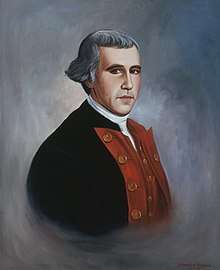Nicholas Biddle (naval officer)
| Nicholas Biddle | |
|---|---|
 Captain Nicholas Biddle by Orlando S. Lagman | |
| Born |
September 10, 1750 Philadelphia |
| Died |
March 7, 1778 (aged 27) Atlantic Ocean |
| Allegiance |
|
| Service/ |
|
| Years of service |
1770–1773 (UK) 1775–1778 (USA) |
| Rank |
|
| Commands held | USS Randolph |
| Battles/wars | |
Nicholas Biddle (September 10, 1750 – March 7, 1778) was one of the first five captains of the Continental Navy, which was raised by the Continental Congress during the American Revolutionary War.
Early life
Nicholas Biddle was born in Philadelphia in 1750, one of nine children to William Biddle (1698–1756) of the Biddle family, and Mary Scull (1709–1789).[1] Biddle went to sea at the age of thirteen, as a ship's boy aboard a merchant vessel trading to the West Indies. In 1770 he joined the Royal Navy and served three years until resigning in 1773 to accompany Captain Constantine Phipps on his expedition to the Arctic Sea. While on this voyage Biddle became acquainted with Horatio Nelson, the future British Admiral and fellow member of Phipps' expedition.[2]
American Revolutionary War
In 1775 Biddle returned to North America to offer his services to the State of Pennsylvania in opposing British rule. With the outbreak of the American Revolutionary War, the Pennsylvania Committee of Safety placed Biddle in command of the armed galley Franklin. In December 1775, Biddle was commissioned into the Continental Navy and made Captain of the 14-gun brig Andrew Doria.[2]
Biddle participated in the expedition against New Providence, and fought in the Continental Navy's action with the Glasgow on April 6, 1776. Biddles was highly critical of the action, noting that the lack of signalling by Commodore Esek Hopkins led to a "helter skelter" action. Biddle would later capture numerous vessels, including British army transports, on later cruises.
Biddle later participated in a cruise of the Newfoundland Banks that was so successful in the taking of ships, that when Biddle returned to port he had only five sailors left on board his ship; the rest were crewing the prizes taken during the cruise.
On June 6, 1776, Biddle was appointed by the Continental Congress to command the Randolph, a 32-gun frigate then being built in Philadelphia. She was launched near the close of the year, and sailed early in 1777. In September 1777, Biddle captured the HMS True Briton and her three-ship convoy.
On March 7, 1778, off Barbados, the Randolph engaged the British 64-gun ship-of-the-line HMS Yarmouth. Rather than trying to flee from the more heavily armed opponent, the Randolph engaged in battle in order to protect an American merchant convoy. An eyewitness reported the frigate held her own in the twenty-minute engagement, appearing, "to fire four or five broadsides to the Yarmouth's one." After Biddle was wounded, the Randolph blew up suddenly, killing all but four of the 305 on board including Biddle. The loss of Randolph was a serious blow to the fledgling Continental Navy.[3][4][5] His body was lost at sea and never recovered.[6]
His brother, Edward Biddle, was a staunch advocate for American independence, and his nephew, Nicholas Biddle, was an esteemed banker.
Four ships of the United States Navy have been named USS Biddle in his honor.
Cyrus Townsend Brady's book For Love of Country is based partly on the life of Nicholas Biddle.
In popular culture
Nicholas Biddle appears in the video game Assassin's Creed III as the primary target of the Naval Missions and the templar captain of the USS Randolph during the American Revolution.[7][8] He first confronts the Assassin Connor Kenway in a tavern but is later stopped by fellow Captain Robert Faulkner, and later on, he confronts Connor again, this time him being older;[9] the two duel after a battle between their two crews. Biddle shoots at a nearby powder keg to take the fight below and give him time to recover. However, Connor kills Biddle before he can kill Connor and asks to die with his ship the Randolph. Contrary to his historic ship battle with the Yarmouth, he confronts rather the Aquila in the game. He also does not die off the coast of Barbados but rather in the Bahamas. He is voiced by Fred Tatiascore.[10]
References
- ↑ McGrath 2015, p. 1.
- 1 2 McGrath 2015, p. 2.
- ↑ Allen 1913, p. 296.
- ↑ Allen 1913, p. 297.
- ↑ Allen 1913, p. 298.
- ↑ Russ (April 21, 2010). "Nicholas Biddle". Find a Grave. Retrieved April 1, 2018.
- ↑ "Nicholas Biddle". IGN. Ziff Davis. December 1, 2012. Retrieved March 31, 2018.
- ↑ "Biddle's Hideout | Naval missions". Game Pressure. GRY-OnLine S.A. Retrieved March 31, 2018.
- ↑ "Le Repère de Biddle". Super Soluce (in French). 2013. Retrieved March 31, 2018.
- ↑ "Nicholas Biddle". Postavy (in Czech). Retrieved March 31, 2018.
Bibliography
- Allen, Gardner Weld (1913). A naval history of the American Revolution. 1. Houghton Mifflin Company. p. 600.
- McGrath, Tim (August 2015). "I Fear Nothing". Naval History. United States Naval Institute. 29 (4).
External links
![]()